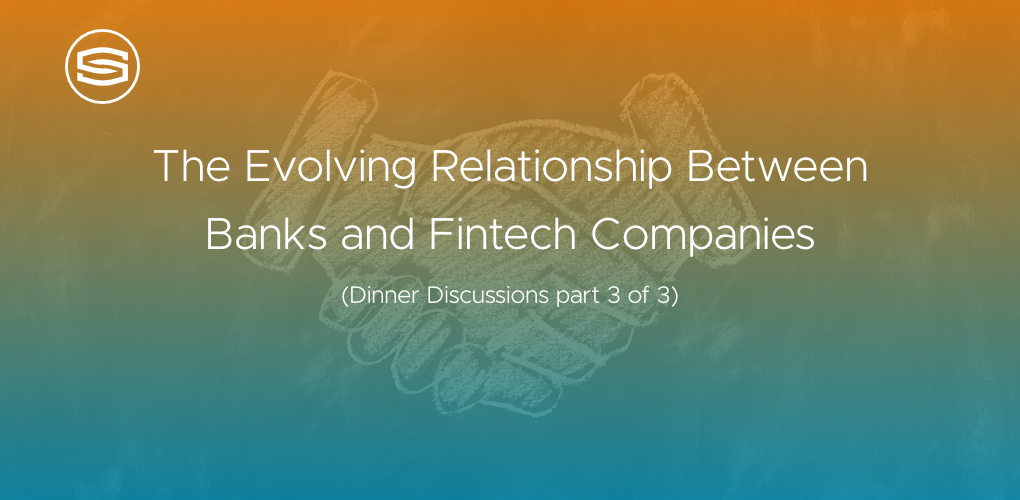
Insights & Opinions
The Evolving Relationship Between Banks and Fintech Companies
Mon, 19 Aug 2024


This is the final post in the “Dinner Discussions” series, sharing the insights and opinions voiced by banking professionals during an intimate round table held after the first day of Money20/20 Europe in June 2024. (You can catch up on part 1 and part 2 on the links if you missed them).
The relationship between traditional banks and fintech companies has evolved dramatically since the financial crisis of 2008. What began as a disruptive force challenging the established financial system has morphed into a complex competition, collaboration, and convergence dynamic. During dessert, we pondered the current state and future prospects of this pivotal relationship in the financial sector.
The Origins and Evolution of Fintech
Fintech emerged from the ashes of the 2008 financial crisis when traditional banks were widely perceived as the culprits of economic turmoil. Fintech companies capitalised on this sentiment, offering innovative solutions that promised greater efficiency, accessibility, and customer-centric services. They quickly gained traction, filling niches that legacy banks had overlooked or under-served.
However, the initial burst of fintech enthusiasm has given way to a more nuanced understanding of their role in the financial ecosystem. The once clear-cut distinction between banks and fintechs is blurring, with each side seeking to adopt the other's strengths. Banks aspire to the agility and innovative spirit of fintechs, while fintechs desire the scale and stability of traditional banks.
The Regulatory Landscape: A Challenge for Fintechs
One of the most significant challenges facing fintechs today is the regulatory environment. Unlike legacy banks, fintech companies often operate under less stringent regulations, initially allowing them to innovate rapidly. However, this regulatory gap is closing, particularly with the introduction of new legislation such as the Digital Operational Resilience Act (DORA).
DORA and other regulatory frameworks aim to ensure that all players in the financial sector, including fintechs, adhere to rigorous standards of security, operational resilience, and consumer protection. This increasing regulatory burden poses a significant challenge for fintechs, many of which are already struggling with debt and operational costs. Whether fintechs can survive under the weight of these new regulations is a pressing concern for the industry.
The Convergence of Banks and Fintechs
As regulatory pressures mount, banks and fintechs are being driven towards convergence. The once adversarial relationship is increasingly giving way to partnerships and collaborations. Many banks have realised that attempting to build fintech capabilities in-house can be costly and time-consuming. Instead, they opt to buy or partner with fintech companies to leverage their innovative solutions.
This convergence has its challenges. The inherent power imbalance between large banks and smaller fintech firms can complicate partnerships. While fintechs bring agility and innovation, they often lack their banking counterparts' resources and market presence. Successful collaboration requires navigating these disparities and finding a balance that allows both parties to thrive.
The Impact of Geopolitical and Economic Factors
Beyond regulatory issues, the broader geopolitical and economic landscape is also shaping the future of fintech. The ongoing geopolitical tensions and economic uncertainties have significant implications for investment in the fintech sector. Participants in the roundtable discussion noted that investment money for fintechs is drying up, making it increasingly difficult for these companies to sustain their operations and scale their innovations.
The drying up of venture capital has forced fintechs to reassess their business models and value propositions. Many fintechs that initially thrived on the promise of high growth now focus on sustainability and profitability. This shift is prompting a reevaluation of what it means to be a viable fintech company in today's market.
The Future of Fintech: Building, Buying, and Beyond
As banks and fintechs navigate this complex landscape, the "build vs buy" dilemma remains a central question. For banks, the decision to develop fintech capabilities internally or acquire existing fintech companies depends on various factors, including cost, strategic fit, and the ability to integrate new technologies seamlessly into existing systems.
For fintechs, the future hinges on their ability to adapt and evolve. While some fintech companies have been highly successful and even sold to larger financial institutions, others struggle to remain viable. The fintechs that succeed will likely be those that can diversify their offerings, address regulatory requirements, and form strategic partnerships with traditional banks.
Conclusion: A Collaborative Future
The relationship between banks and fintechs is no longer defined by simple opposition. Instead, it is characterised by a complex interplay of competition, collaboration, and convergence. As the financial sector continues to evolve, banks and fintechs must work together to navigate the challenges and seize the opportunities that lie ahead.
For banks, this means embracing the innovative potential of fintechs while maintaining the stability and trust that customers expect. For fintechs, it means adapting to a more regulated environment and finding sustainable paths to growth. Ultimately, the future of the financial industry will be shaped by the ability of these two forces to collaborate effectively and drive forward innovation in a way that benefits all stakeholders.



